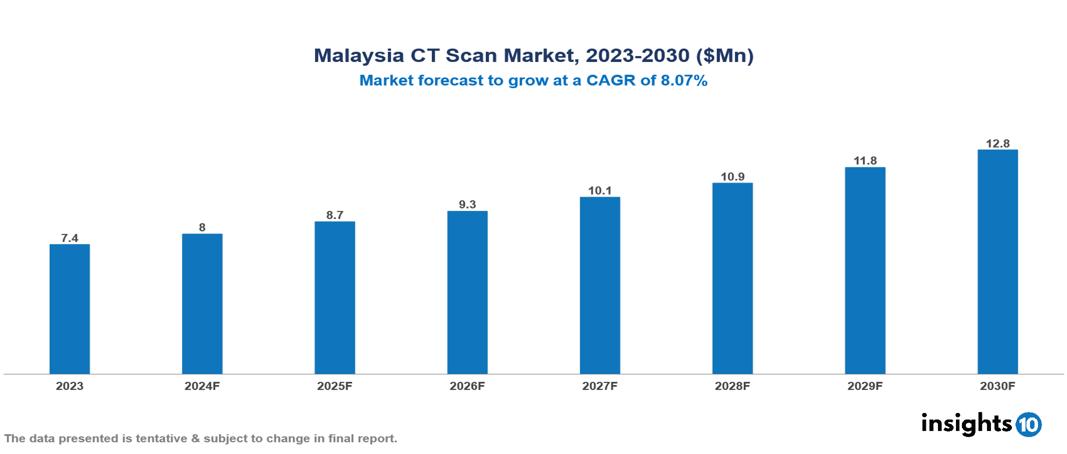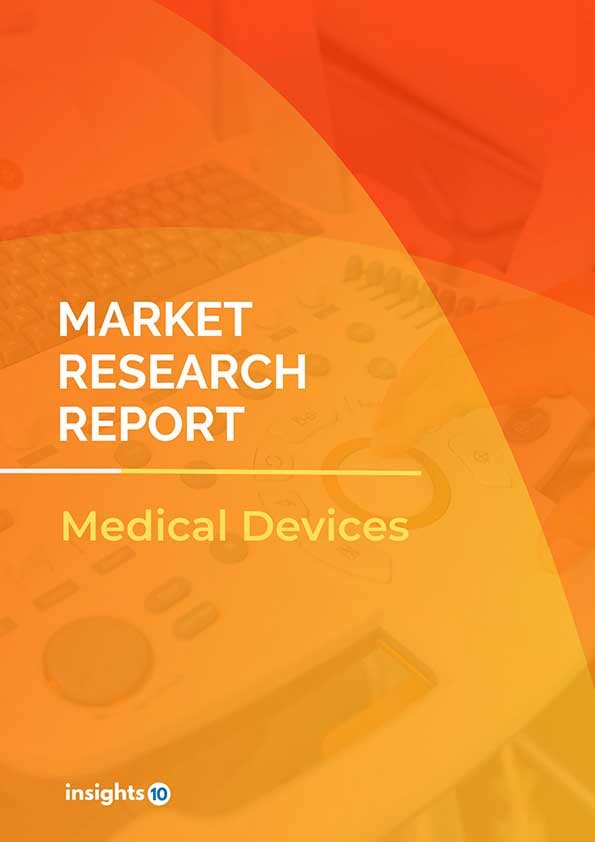Malaysia CT Scan Market Analysis
Malaysia CT Scan Market was valued at $7.41 Mn in 2023 and is predicted to grow at a CAGR of 8.07% from 2023 to 2030, to $12.76 Mn by 2030. The key drivers of this industry include the rising burden of chronic diseases, government initiatives, and growing technological advancements. The industry is primarily dominated by GE HealthCare, Siemens Healthineers, Canon Medical Systems, and NeuroLogica Corp. among others.
Buy Now

Malaysia CT Scan Market Executive Summary
Malaysia CT Scan Market was valued at $7.41Mn in 2023 and is predicted to grow at a CAGR of 8.07% from 2023 to 2030, to $12.76 Mn by 2030.
A CT scan, or computed tomography scan, is a sophisticated imaging procedure that uses X-rays to produce detailed cross-sectional images of the body. Unlike traditional X-rays, CT scans capture multiple views from various angles, which a computer then processes into a three-dimensional representation of internal structures such as organs, bones, and soft tissues. Before the scan, patients may prepare by wearing a gown and removing metal objects. Depending on the type of scan, they might need to ingest a contrast material to enhance the visibility of specific tissues. During the scan, patients lie on a table that moves through a donut-shaped scanner while X-ray images are taken. Afterward, a radiologist interprets the images to diagnose conditions like cancer, heart disease, bone fractures, internal bleeding, and injuries. While CT scans offer detailed diagnostic capabilities, they involve radiation exposure and can be costly, though advancements have minimized risks and enhanced safety. Other imaging options like X-rays, ultrasound, and MRI scans are considered based on specific medical needs and radiation concerns.
Chronic diseases, which account for over 74% of global deaths annually according to the World Health Organization (WHO), are primarily managed through ongoing medical interventions. These include cardiovascular diseases (responsible for 17.9 Mn deaths annually), cancers (resulting in 9.3 Mn deaths annually), chronic respiratory diseases (causing 4.1 Mn deaths annually), and diabetes-related complications (contributing to 2.0 Mn deaths annually). Chronic illness prevalence was higher among females (16.8%). In 2016, Malaysia had 1.58 doctors, 3.24 nurses, and 1.44 hospital beds per 1,000 population, with 3.78 MRI and 5.12 CT scan machines per Mn population in 2010.
The market is therefore driven by significant factors like the rising burden of chronic diseases, supportive government initiatives, and growing technological advancements. However, high costs, skilled workforce shortages, and limited reimbursement restrict the growth and potential of the market.
A prominent player in this field is GE Healthcare, which launched a new refurbishing unit in Bangladesh for A1-Sure Ultrasound Systems, aiming to enhance accessibility to affordable ultrasound technology in developing regions, and Siemens Healthineers partnered with Microsoft to utilize Azure cloud services for AI-powered medical imaging solutions, aimed at advancing healthcare delivery with secure and scalable cloud computing. Other contributors include Canon Medical Systems, and NeuroLogica Corp. among others.

Market Dynamics
Market Growth Drivers
Rising Burden of Chronic Diseases: Malaysia faces a growing burden of chronic illnesses like heart disease, cancer, and diabetes. According to the National Health Morbidity Survey 2019, 3 out of 10 adults in Malaysia have high blood pressure, a significant risk factor for heart disease. Similarly, cancer is a leading cause of death, with an estimated 36,000 new cases annually according to National Cancer Society Malaysia in 2022. CT scans are crucial for diagnosing and managing these chronic diseases, propelling market growth.
Supportive Government Initiatives: The Malaysian government prioritizes healthcare development. Increased healthcare expenditure translates to more investment in medical equipment like CT scanners. For instance, the Ministry of Health's 2023 budget allocated funds for upgrading medical facilities with advanced diagnostic equipment. This government backing fosters market expansion.
Growing Technological Advancements: The Malaysian healthcare sector is embracing advancements in CT scan technology. Hospitals are increasingly adopting multi-slice CT scanners, offering faster scan times, higher-resolution images, and lower radiation doses. This focus on advanced technology attracts patients seeking high-quality diagnostics and fuels market growth.
Market Restraints
High Costs: CT scanners are expensive, with acquisition costs ranging from $125,000 to $500,000 in 2021. This can limit affordability for smaller hospitals and clinics, hindering wider market penetration.
Skilled Workforce Shortage: Operating and interpreting CT scans requires specialized training. A lack of qualified radiologists and technicians, particularly in rural areas, can hinder efficient CT scan utilization and market growth.
Limited Reimbursement: Reimbursement for CT scans in Malaysia can be complex, with varying coverage depending on insurance plans and procedures. This can create a financial burden for patients, potentially discouraging unnecessary scans but also limiting access for some who need them.
Regulatory Landscape and Reimbursement Scenario
In Malaysia, the regulatory landscape governing CT scanners involves stringent guidelines set by the Medical Device Authority (MDA). CT scanners are classified as Class C medical devices, requiring registration and compliance with strict quality and safety standards before they can be marketed or used clinically. Manufacturers and distributors must navigate through comprehensive regulatory processes, including product registration, conformity assessment, and post-market surveillance to ensure ongoing compliance with Malaysian regulations. These regulations aim to safeguard patient safety and ensure the efficacy of diagnostic imaging technologies throughout their lifecycle, from procurement to operational use in healthcare facilities across the country.
Regarding reimbursement, the accessibility of CT scans in Malaysia is largely influenced by the country's healthcare financing system, which includes both public and private sectors. Public healthcare facilities generally provide CT scans as part of subsidized or fully covered services for eligible patients, supported by government healthcare budgets and insurance schemes. However, reimbursement policies in private healthcare settings can vary, often dependent on individual insurance coverage and specific reimbursement agreements between healthcare providers and insurers. This variability can impact the affordability and availability of CT scans for patients seeking diagnostic imaging services outside of public healthcare channels, potentially influencing market dynamics and healthcare delivery strategies in Malaysia.
Competitive Landscape
Key Players
Here are some of the major key players in the Malaysia CT Scan Market:
- GE HealthCare
- Koninklijke Philips N.V.
- Siemens Healthineers AG
- Canon Medical Systems
- NeuroLogica Corp.
- Shanghai United Imaging Healthcare Co., Ltd.
- Fujifilm Holdings Corporation
- Shenzhen Anke High-tech Co., Ltd.
- Koning Health
- Carestream Dental LLC.
1. Executive Summary
1.1 Device Overview
1.2 Global Scenario
1.3 Country Overview
1.4 Healthcare Scenario in Country
1.5 Regulatory Landscape for Medical Device
1.6 Health Insurance Coverage in Country
1.7 Type of Medical Device
1.8 Recent Developments in the Country
2. Market Size and Forecasting
2.1 Market Size (With Excel and Methodology)
2.2 Market Segmentation (Check all Segments in Segmentation Section)
3. Market Dynamics
3.1 Market Drivers
3.2 Market Restraints
4. Competitive Landscape
4.1 Major Market Share
4.2 Key Company Profile (Check all Companies in the Summary Section)
4.2.1 Company
4.2.1.1 Overview
4.2.1.2 Product Applications and Services
4.2.1.3 Recent Developments
4.2.1.4 Partnerships Ecosystem
4.2.1.5 Financials (Based on Availability)
5. Reimbursement Scenario
5.1 Reimbursement Regulation
5.2 Reimbursement Process for Diagnosis
5.3 Reimbursement Process for Treatment
6. Methodology and Scope
Malaysia CT Scan Market Segmentation
By Technology
- High-end Slice CT
- Mid-end Slice CT
- Low-end Slice CT
- Cone Beam CT (CBCT)
By Application
- Oncology
- Cardiology
- Vascular
- Neurology
- Musculoskeletal
- Others
By Modality
- O-Arms
- C- Arms
By End-User
- Hospitals
- Diagnostic Imaging Centers
- Others
Methodology for Database Creation
Our database offers a comprehensive list of healthcare centers, meticulously curated to provide detailed information on a wide range of specialties and services. It includes top-tier hospitals, clinics, and diagnostic facilities across 30 countries and 24 specialties, ensuring users can find the healthcare services they need.
Additionally, we provide a comprehensive list of Key Opinion Leaders (KOLs) based on your requirements. Our curated list captures various crucial aspects of the KOLs, offering more than just general information. Whether you're looking to boost brand awareness, drive engagement, or launch a new product, our extensive list of KOLs ensures you have the right experts by your side. Covering 30 countries and 36 specialties, our database guarantees access to the best KOLs in the healthcare industry, supporting strategic decisions and enhancing your initiatives.
How Do We Get It?
Our database is created and maintained through a combination of secondary and primary research methodologies.
1. Secondary Research
With many years of experience in the healthcare field, we have our own rich proprietary data from various past projects. This historical data serves as the foundation for our database. Our continuous process of gathering data involves:
- Analyzing historical proprietary data collected from multiple projects.
- Regularly updating our existing data sets with new findings and trends.
- Ensuring data consistency and accuracy through rigorous validation processes.
With extensive experience in the field, we have developed a proprietary GenAI-based technology that is uniquely tailored to our organization. This advanced technology enables us to scan a wide array of relevant information sources across the internet. Our data-gathering process includes:
- Searching through academic conferences, published research, citations, and social media platforms
- Collecting and compiling diverse data to build a comprehensive and detailed database
- Continuously updating our database with new information to ensure its relevance and accuracy
2. Primary Research
To complement and validate our secondary data, we engage in primary research through local tie-ups and partnerships. This process involves:
- Collaborating with local healthcare providers, hospitals, and clinics to gather real-time data.
- Conducting surveys, interviews, and field studies to collect fresh data directly from the source.
- Continuously refreshing our database to ensure that the information remains current and reliable.
- Validating secondary data through cross-referencing with primary data to ensure accuracy and relevance.
Combining Secondary and Primary Research
By integrating both secondary and primary research methodologies, we ensure that our database is comprehensive, accurate, and up-to-date. The combined process involves:
- Merging historical data from secondary research with real-time data from primary research.
- Conducting thorough data validation and cleansing to remove inconsistencies and errors.
- Organizing data into a structured format that is easily accessible and usable for various applications.
- Continuously monitoring and updating the database to reflect the latest developments and trends in the healthcare field.
Through this meticulous process, we create a final database tailored to each region and domain within the healthcare industry. This approach ensures that our clients receive reliable and relevant data, empowering them to make informed decisions and drive innovation in their respective fields.
To request a free sample copy of this report, please complete the form below.
We value your inquiry and offer free customization with every report to fulfil your exact research needs.








































